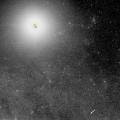Alpha Centauriis the brightest star in the southern constellation of Centaurus. To the unaided eye it appears as a single star, whose total visual magnitude would identify it as the third brightest star in the night sky. However, Alpha Centauri is
actually a binary star system, composed of the two stars Alpha Centauri A (α Cen A) and Alpha Centauri B (α Cen B). Of the two, Alpha Centauri A is by far the brightest; it also has slightly more mass than Alpha Centauri B. To make explicit that the full binary star system is referred to, the designation Alpha Centauri AB (α Cen AB) is used.
Alpha Centauri AB is 1.34 parsecs or 4.37 light years away from our Sun.[9] The two stars are the closest stars to the Sun after their companion Proxima Centauri, at 0.21 light years away from the two, and at 4.243 light years away from the Sun.
"Alpha Centauri" is the name given to what appears as a single star to the naked eye and the brightest star in the southern constellation of Centaurus. With the aid of a telescope, Alpha Centauri can be resolved into a binary star system in close orbit. This is known as the Alpha Centauri AB system, often abbreviated as α Centauri AB or α Cen AB.
Alpha Centauri A (α Cen A) and Alpha Centauri B (α Cen B) are the individual stars of the binary system, usually defined to identify them as the different component of the binary α Cen AB. As viewed from Earth, there is an additional companion located 2.18° away from the AB star system, a distance much greater than the observed separation between stars A and B. This companion is called Proxima Centauri, Proxima, or α Cen C. If it were bright enough to be seen without a telescope, Proxima Centauri would appear to the naked eye as a star separate from α Cen AB. Alpha Centauri AB and Proxima Centauri form a visual double star, and they are assumed to be gravitationally associated with each other. Direct evidence that Proxima Centauri has an elliptical orbit typical of binary stars has yet to be found.[10]
Together all three components make a triple star system, referred to by double-star observers as the triple star (or multiple star), α Cen AB-C.
This naming system allows specialist double-star astronomers to define system components and the relationships between the different components. All component designations are held and controlled by the U.S. Naval Observatory, in a continuously updated catalogue called the Washington Double Star Catalogue or WDS. It contains over 102,387 double stars or pairs using this system of designation.
Any hypothetical planet orbiting around either Alpha Centauri A or Alpha Centauri B would see an intensely bright star in the sky showing a small but discernible disk.
For example, some theoretical Earth-like planet orbiting about 1.25 Astronomical unit (AU) from Alpha Centauri A would see a solar-like Alpha Centauri B orbit the entire sky once roughly every one year three months or 1.3(4) a) - corresponding to the planet's own orbital period. Added to this would be the changing apparent positions of Alpha Centauri B during its long eighty-year elliptical orbit with respect to Alpha Centauri A. Depending on respective apparent places during its orbit, Alpha Centauri B would appear to vary in visual brightness anywhere between -18.2 magnitude (dimmest) to -21.0 (brightest). These visual magnitudes are much dimmer than the currently observed -26.7 magnitude for the Sun as viewed from the Earth. Differences of 5.7 to 8.6 magnitudes corresponds to respective brightness ratios 2700 to 190 times dimmer than Alpha Centauri A. In comparative terms of brightness ratios, Earth bound observers looking at the -12.0 magnitude full moon would see Alpha Centauri B appearing 2300 to 170 times brighter than it.
Also, if another similar Earth-like planet orbited at 0.71 A.U. from Alpha Centauri B, this theoretical planet would receive slightly more light from the more luminous Alpha Centauri A, and would shine 4.7 to 7.3 magnitudes dimmer than the Sun, or ranging in respective visual magnitude between -22.1 (brightest) to -19.4 (dimmest). In the sky, Alpha Centauri B could be between 840 times down to 180 times dimmer than the Sun or brighter by some 6300 to 520 times than that of the full moon. During this hypothetical planetary period or year of 0.6(3) a would see this intensely bright companion star circle across the sky throughout the year just as we see with the Solar System's planets. Furthermore, Alpha Centauri B sidereal period of eighty-odd years means that this star would move through the local ecliptic as slow as Uranus' eight-four year period , but as the orbit is more elliptical, the apparent brightness will appear far more variable. Although intensely bright to the eye, the overall illumination would not significantly affect climate nor influence normal plant photosynthesis.

No comments:
Post a Comment